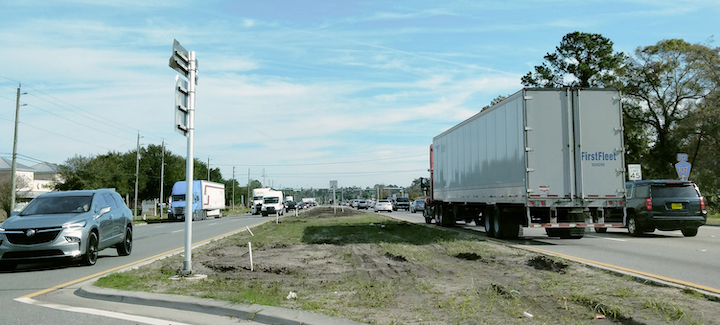
By Wilma Allen
The median strips along state Route 200, as you drive to and from Amelia Island, are looking pretty grim lately. They are being prepped for landscaping, the final phase of the road widening project that the Florida Department of Transportation (FDOT) has been working on for years and years.
FDOT is responsible for the construction and maintenance of this state road. The budget is $6.9 million for landscaping the entire project from Interstate Highway 95 east to Old Nassauville Road, just before the Shave Bridge. About 40% of this $2.9 million budget is earmarked for the busiest section of highway between Old Nassauville Road, and U.S. Highway 17 in Yulee. It stretches roughly 6.5 miles, past Lowe’s, two car dealerships, Walmart Supercenter, three car washes, big box and grocery stores, multiple shopping centers and gas stations, doctors and dentists, banks, restaurants, a school, government buildings and many more. Parking lots, asphalt, traffic lights, busy intersections and turn lanes abound in both directions. Mature trees and naturally wooded areas along the route are in short supply.
According to FDOT’s website, FDOT.gov, the department’s policy when constructing and maintaining state highways, is “to conserve, protect, restore, and enhance Florida’s natural resources and scenic beauty.” This policy enables Florida to have: “the nation’s most beautiful highways that attract and grow business; safe roadsides that are durable, and ecologically and economically sustainable; measurable returns on investments that grow in value over time.” Motorist safety and visibility are top priorities, but FDOT’s landscape design strategy aims to “enhance Florida’s distinctive sense of place, create lasting curb appeal, and minimize the cost to conserve and maintain high-quality landscapes.”
Highly detailed landscape plans indicate that islands here and there along this section of roadway, will be planted with clusters of hardy trees and shrubs. These include cathedral live oaks, slash pine, cabbage palms of various sizes, coontie palms, and saw palmetto. Sod and perennial peanut (the pretty yellow flowers on Amelia Island’s Eighth Street median) will be used as ground cover. Most of the plants will be placed in curving beds in the least developed stretches of roadway – the Mt. Zion Loop area, across from the Target/Home Depot shopping center, and west, past Miner Road. In addition, clumps of trees will be wedged between several entrances and exits along the route. Beyond Miner Road, there is less development and more trees are possible. Trees, set back on the sides of the road, appear to be the responsibility of the property owners.
Extensive irrigation and drainage plans are well underway to keep the plants healthy. Planting will be next. This means construction delays will likely continue for many more months. But by this time next year, if the landscaping lives up to FDOT’s stated policy, there may finally be something attractive to enhance this now bleak gateway to Amelia Island.

While most of the plants mentioned in the article are native to Florida, I hope that all the landscaping includes native flora. Native plants adapted to our environment take less maintenance, including water, are just as attractive as other foreign plants, and also attract native pollinators and their predators. Let’s hope FDOT goes native!
Completely agree! Perennial peanut is « nice « but NATIVES are better! Frogfruit, beach dune sunflower are two natives that would both belong sustain the soil AND provide for pollinators. Gopher apple would be a GREAT low growing plant to place instead of « shrubs ». Saw palmetto are beautiful, but over time grow large and obscure views . That is the only bad thing about them. Coontie is a great choice. NO SOD, more PERENNIALS for pollinators !! NATIVE MILKWEEDS for monarchs to make up for the rural areas they are destroying ! What about some coreopsis, the Fl state wildflower?? Perhaps it isn’t too late to reach out to FDOT to make suggestions ?
Peanut grass is beautiful but it attracts deer. I hope that was a consideration during planning.
Wait 10+ years. The road will eventually be widened to have a barrier between eastbound and westbound lanes with no landscaping. “Progress.” “It adds to the tax base.” “Jobs.” Come to Pinellas County and see the progress on US 19.
You’re probably right. Nassau County has been growing exponentially, but until then we can hope that they do something positive with it. I reached out to DOT to ask if they are going to utilize more natives than not. Waiting to hear back from them now. Lived here my whole life and never thought it would reach a point where the working class could no longer afford to buy a home here. Had I not built 20 years ago, I would be in a fix. 🙁 The whole state is becoming a gentrified mess. 🙁
Great article. I was wondering what the State was planning to plant.